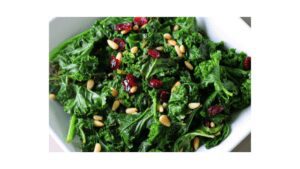Introduction
Kale is botanically known as Brassica oleracea var. Acephala. This plant belongs to the Brassicaceae family with large, curled leaves as an edible part. Kale variety mainly depends on the green or red-purple color of the leaf and bolting stem part. The stem of kale is very crispy and tender with an attractive flavor therefore popularly known as “green superfood”(1). Some of the kale health benefits are as follows.
Why Kale is called a superfood?
Per 100 grams serving of Kale provides an intake of minerals like iron, calcium, and magnesium. Fresh kale is low in calories (36–98 kcal/100 g) with moderate levels of protein (1.6–5.9 g/100 g). It is also a source of 0.4–6.7 g of prebiotic carbohydrates hence is a significant food (2).
Kale is of family Brassicaceae which also includes other vegetables like cabbage, broccoli, cauliflower, kale, Brussels sprouts, collard greens, savoy, kohlrabi, and Chinese kale (3). Kale ranked 15th in “powerhouse fruits and vegetables” by the Food and Agriculture Organization of the United Nations and Institute of Medicine (4).
Nutritional value of Kale
Kale is rich in phytonutrients, secondary metabolites, macro, and microelements. Kale contains a maximum amount of lutein and zeaxanthin (5). Other nutritive components of Kale are as follows (6).
| Compound | Amounts per 100 g. |
| Water | 89.63 g |
| Energy | 35 kcal |
| Protein | 2.92 g |
| Total lipid (Fat)s | 1.49 g |
| Carbohydrates | 4.42 g |
| Dietary Fiber | 4.1 g |
| Sugar | 0.99 g |
| Vitamins | |
| Folates | 62 µg |
| Niacin | 1.18 mg |
| Riboflavin | 0.34 mg |
| Thiamin | 0.11 mg |
| Vitamin B-6 | 0.14 mg |
| Vitamin A | 4812 IU |
| Vitamin E | 0.66 mg |
| Vitamin C | 93.4 mg |
| Vitamin K | 389.6 µg |
| Minerals | |
| Calcium | 254 mg |
| Iron | 1.60 mg |
| Magnesium | 33 mg |
| Phosphorous | 55 mg |
| Zinc | 0.39 mg |
| Sodium | 53 mg |
| Potassium | 348 mg |
Health benefits of Kale
1. Boost immunity
High antioxidants, vitamin C, β-carotene, fibers, and other minerals of Kale provide protection against oxidative stress and enhances the immunity of the body. Single serving size of kale full 100% RDI of Vitamin A and 40% of Vitamin C (7).
2. Anti-inflammatory and anticancer
Eating kale prevents Gastroesophageal reflux disease and esophageal cancer. The Sulforaphane compound of Kale acts as a therapeutic anti-inflammatory and anti-cancer agent (8).
3. Antidiabetic
Dietary fibers present in kale prevents postprandial elevation of plasma glucose levels (140–187 mg/dl) by an increase in intestinal viscosity. Which further delays the absorption of nutrients (9). Thus prevents diabetes.
4. Healthy heart
Omega-3 -fatty acids in Kale juice is good for the heart as it reduces the cholesterol level of the body. Therefore having Kale juice prevents the risk of coronary artery diseases (10).
5. Good for eyes
Lutein and zeaxanthin of Kale protect the retina and cornea from age-related disorders such as cataracts, glaucoma, and macular degeneration (11).
6. Strong bone
Kale is an excellent source of vitamin K, easily accessible and inexpensive, which prevents bone mass loss in postmenopausal patients (12).
7. Improves digestion
Prebiotic carbohydrates in Kale promote intestinal microbial diversity. Enhances the immune system, and mineral absorption. It also decreases the risk of colon cancer (13).
8. Protects neurological disorders
Kale is an excellent source of folate and kale seeds is effective acetylcholinesterase inhibitor thus may be helpful for the treatment of neurological diseases such as in Alzheimer’s disease, senile dementia, ataxia, myasthenia gravis, and Parkinson’s disease (14).
9. Improves metabolic syndrome
Metabolic syndrome is a mixture of disorders like abdominal obesity, hypertension, hyperglycemia, and disorder of lipid metabolism. Which further increases the risk for arteriosclerotic diseases such as cardiac disease and stroke.
Kale powder or juice decreases blood pressure, fasting blood sugar, and abdominal circumference. As it contains soluble fiber, potassium, calcium, and polyphenols (15).
Side effects of Kale
1. Antinutrients
Oxalates, phytate, and tannins present in Kale may be harmful in high amounts. Excessive intake, therefore, interferes in many physiological pathways and the absorption of beneficial nutrients (16).
2. Thallium accumulation
Kale possesses the property to accumulate thallium in contaminated soil which can be can be a serious danger for food chains however, transfer of thallium into kale decreases with time (17).
Healthy Recipes of Kale
1. Kale Salad

Chopped kale mix with onion, broccoli, carrots, tomato, and olive oil also can add lemon juice for better taste.
2. Kale Chips

Studies suggested that Kale chips possess all the nutrients hence can be eaten as a healthy snack.
3. Kale Juice

Kale leaves produce a nutritious juice with cucumber, spinach or banana, blueberries.
Difference between kale and Spinach
Kale and Spinach both are very different in their nutrient content. Vitamin C is higher in Kale than that of Spinach. However, the concentration of β-carotene and lutein is similar to spinach.
